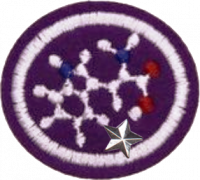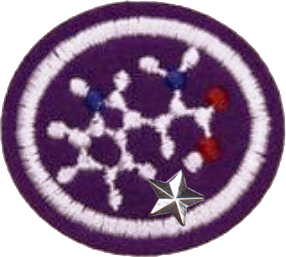Difference between revisions of "AY Honors/Biochemistry - Advanced/Requirements"
Jomegat bot (talk | contribs) (Bot: Automated import of articles *** existing text overwritten ***) |
m (- Category of Honor Requirements) |
||
| (7 intermediate revisions by 2 users not shown) | |||
| Line 1: | Line 1: | ||
| − | + | {{HonorSubpage}} | |
| − | |||
| − | {{ | ||
<section begin=Body /> | <section begin=Body /> | ||
| − | + | <b>1. <section begin=req1 /><noinclude><translate><!--T:1--> | |
| − | <b>1. <section begin=req1 /><noinclude><translate></noinclude>Have the Biochemistry honor. | + | </noinclude>Have the Biochemistry honor. |
<noinclude></translate></noinclude><section end=req1 /></b> | <noinclude></translate></noinclude><section end=req1 /></b> | ||
| − | <b>2. <section begin=req2 /><noinclude><translate></noinclude>Define the following terms: | + | <b>2. <section begin=req2 /><noinclude><translate><!--T:2--> |
| + | </noinclude>Define the following terms: | ||
<noinclude></translate></noinclude><section end=req2 /></b> | <noinclude></translate></noinclude><section end=req2 /></b> | ||
| − | :<b>a. <section begin=req2a /><noinclude><translate></noinclude>Synthesis | + | :<b>a. <section begin=req2a /><noinclude><translate><!--T:3--> |
| + | </noinclude>Synthesis | ||
<noinclude></translate></noinclude><section end=req2a /></b> | <noinclude></translate></noinclude><section end=req2a /></b> | ||
| − | :<b>b. <section begin=req2b /><noinclude><translate></noinclude>Anabolism | + | :<b>b. <section begin=req2b /><noinclude><translate><!--T:4--> |
| + | </noinclude>Anabolism | ||
<noinclude></translate></noinclude><section end=req2b /></b> | <noinclude></translate></noinclude><section end=req2b /></b> | ||
| − | :<b>c. <section begin=req2c /><noinclude><translate></noinclude>Catabolism | + | :<b>c. <section begin=req2c /><noinclude><translate><!--T:5--> |
| + | </noinclude>Catabolism | ||
<noinclude></translate></noinclude><section end=req2c /></b> | <noinclude></translate></noinclude><section end=req2c /></b> | ||
| − | :<b>d. <section begin=req2d /><noinclude><translate></noinclude>Reduction | + | :<b>d. <section begin=req2d /><noinclude><translate><!--T:6--> |
| + | </noinclude>Reduction | ||
<noinclude></translate></noinclude><section end=req2d /></b> | <noinclude></translate></noinclude><section end=req2d /></b> | ||
| − | :<b>e. <section begin=req2e /><noinclude><translate></noinclude>Oxidation | + | :<b>e. <section begin=req2e /><noinclude><translate><!--T:7--> |
| + | </noinclude>Oxidation | ||
<noinclude></translate></noinclude><section end=req2e /></b> | <noinclude></translate></noinclude><section end=req2e /></b> | ||
| − | :<b>f. <section begin=req2f /><noinclude><translate></noinclude>Photosynthesis | + | :<b>f. <section begin=req2f /><noinclude><translate><!--T:8--> |
| + | </noinclude>Photosynthesis | ||
<noinclude></translate></noinclude><section end=req2f /></b> | <noinclude></translate></noinclude><section end=req2f /></b> | ||
| − | :<b>g. <section begin=req2g /><noinclude><translate></noinclude>Hormone | + | :<b>g. <section begin=req2g /><noinclude><translate><!--T:9--> |
| + | </noinclude>Hormone | ||
<noinclude></translate></noinclude><section end=req2g /></b> | <noinclude></translate></noinclude><section end=req2g /></b> | ||
| − | <b>3. <section begin=req3 /><noinclude><translate></noinclude>Other than energy provision, what other functions do carbohydrates have? | + | <b>3. <section begin=req3 /><noinclude><translate><!--T:10--> |
| + | </noinclude>Other than energy provision, what other functions do carbohydrates have? | ||
<noinclude></translate></noinclude><section end=req3 /></b> | <noinclude></translate></noinclude><section end=req3 /></b> | ||
| − | <b>4. <section begin=req4 /><noinclude><translate></noinclude>How are carbohydrates classified? | + | <b>4. <section begin=req4 /><noinclude><translate><!--T:11--> |
| + | </noinclude>How are carbohydrates classified? | ||
<noinclude></translate></noinclude><section end=req4 /></b> | <noinclude></translate></noinclude><section end=req4 /></b> | ||
| − | <b>5. <section begin=req5 /><noinclude><translate></noinclude>What are the consequences of lack of glucose in the body? | + | <b>5. <section begin=req5 /><noinclude><translate><!--T:12--> |
| + | </noinclude>What are the consequences of lack of glucose in the body? | ||
<noinclude></translate></noinclude><section end=req5 /></b> | <noinclude></translate></noinclude><section end=req5 /></b> | ||
| − | <b>6. <section begin=req6 /><noinclude><translate></noinclude>To keep glucose rates constant, in the fasting period, the body is able to produce this carbohydrate. How does the gluconeogenesis pathway occur? | + | <b>6. <section begin=req6 /><noinclude><translate><!--T:13--> |
| + | </noinclude>To keep glucose rates constant, in the fasting period, the body is able to produce this carbohydrate. How does the gluconeogenesis pathway occur? | ||
<noinclude></translate></noinclude><section end=req6 /></b> | <noinclude></translate></noinclude><section end=req6 /></b> | ||
| − | <b>7. <section begin=req7 /><noinclude><translate></noinclude>What is the importance of the hormones insulin and glucagon in the human body? | + | <b>7. <section begin=req7 /><noinclude><translate><!--T:14--> |
| + | </noinclude>What is the importance of the hormones insulin and glucagon in the human body? | ||
<noinclude></translate></noinclude><section end=req7 /></b> | <noinclude></translate></noinclude><section end=req7 /></b> | ||
| − | <b>8. <section begin=req8 /><noinclude><translate></noinclude>How does an individual's metabolism fast? | + | <b>8. <section begin=req8 /><noinclude><translate><!--T:15--> |
| + | </noinclude>How does an individual's metabolism fast? | ||
<noinclude></translate></noinclude><section end=req8 /></b> | <noinclude></translate></noinclude><section end=req8 /></b> | ||
| − | <b>9. <section begin=req9 /><noinclude><translate></noinclude>How is an individual's metabolism well-fed? | + | <b>9. <section begin=req9 /><noinclude><translate><!--T:16--> |
| + | </noinclude>How is an individual's metabolism well-fed? | ||
<noinclude></translate></noinclude><section end=req9 /></b> | <noinclude></translate></noinclude><section end=req9 /></b> | ||
| − | <b>10. <section begin=req10 /><noinclude><translate></noinclude>What disease is a result of lack of insulin production? What are the main characteristics of this disease? | + | <b>10. <section begin=req10 /><noinclude><translate><!--T:17--> |
| + | </noinclude>What disease is a result of lack of insulin production? What are the main characteristics of this disease? | ||
<noinclude></translate></noinclude><section end=req10 /></b> | <noinclude></translate></noinclude><section end=req10 /></b> | ||
| − | <b>11. <section begin=req11 /><noinclude><translate></noinclude>The excess carbohydrates and amino acids accumulate in the body through its conversion into lipids. How are lipids synthesized in the body? Where are they stored? | + | <b>11. <section begin=req11 /><noinclude><translate><!--T:18--> |
| + | </noinclude>The excess carbohydrates and amino acids accumulate in the body through its conversion into lipids. How are lipids synthesized in the body? Where are they stored? | ||
<noinclude></translate></noinclude><section end=req11 /></b> | <noinclude></translate></noinclude><section end=req11 /></b> | ||
| − | <b>12. <section begin=req12 /><noinclude><translate></noinclude>What are the types of lipids in humans? | + | <b>12. <section begin=req12 /><noinclude><translate><!--T:19--> |
| + | </noinclude>What are the types of lipids in humans? | ||
<noinclude></translate></noinclude><section end=req12 /></b> | <noinclude></translate></noinclude><section end=req12 /></b> | ||
| − | <b>13. <section begin=req13 /><noinclude><translate></noinclude>Amino acids are produced by living things. The so-called producers are able to synthesize the 20 essential amino acids, mammals can synthesize only a few. What are the precursors used for amino acid synthesis? | + | <b>13. <section begin=req13 /><noinclude><translate><!--T:20--> |
| + | </noinclude>Amino acids are produced by living things. The so-called producers are able to synthesize the 20 essential amino acids, mammals can synthesize only a few. What are the precursors used for amino acid synthesis? | ||
<noinclude></translate></noinclude><section end=req13 /></b> | <noinclude></translate></noinclude><section end=req13 /></b> | ||
| − | <b>14. <section begin=req14 /><noinclude><translate></noinclude>How do mammals get the amino acids they are not able to synthesize? | + | <b>14. <section begin=req14 /><noinclude><translate><!--T:21--> |
| + | </noinclude>How do mammals get the amino acids they are not able to synthesize? | ||
<noinclude></translate></noinclude><section end=req14 /></b> | <noinclude></translate></noinclude><section end=req14 /></b> | ||
| − | <b>15. <section begin=req15 /><noinclude><translate></noinclude>Make a table with the biosynthetic families of amino acids, according to metabolic precursors. | + | <section begin=challenge /> |
| + | <b>15. <section begin=req15 /><noinclude><translate><!--T:22--> | ||
| + | </noinclude>Make a table with the biosynthetic families of amino acids, according to metabolic precursors. | ||
<noinclude></translate></noinclude><section end=req15 /></b> | <noinclude></translate></noinclude><section end=req15 /></b> | ||
| + | <section end=challenge /> | ||
| − | <b>16. <section begin=req16 /><noinclude><translate></noinclude>The amino group is very important for the synthesis of amino acids. How do you get this amino grouping? Explain the Cycle of Nitrogen. | + | <b>16. <section begin=req16 /><noinclude><translate><!--T:23--> |
| + | </noinclude>The amino group is very important for the synthesis of amino acids. How do you get this amino grouping? Explain the Cycle of Nitrogen. | ||
<noinclude></translate></noinclude><section end=req16 /></b> | <noinclude></translate></noinclude><section end=req16 /></b> | ||
| − | <b>17. <section begin=req17 /><noinclude><translate></noinclude>Nitrogen fixation is very important, certain bacteria do this. Some live in symbiosis with legumes. Explain how the symbiosis between bacteria and legumes occurs. Associate legumes and nitrogen fixation with crop rotation. | + | <b>17. <section begin=req17 /><noinclude><translate><!--T:24--> |
| + | </noinclude>Nitrogen fixation is very important, certain bacteria do this. Some live in symbiosis with legumes. Explain how the symbiosis between bacteria and legumes occurs. Associate legumes and nitrogen fixation with crop rotation. | ||
<noinclude></translate></noinclude><section end=req17 /></b> | <noinclude></translate></noinclude><section end=req17 /></b> | ||
| − | <b>18. <section begin=req18 /><noinclude><translate></noinclude>How does photosynthesis happen and what is its importance for life on Earth? | + | <b>18. <section begin=req18 /><noinclude><translate><!--T:25--> |
| + | </noinclude>How does photosynthesis happen and what is its importance for life on Earth? | ||
<noinclude></translate></noinclude><section end=req18 /></b> | <noinclude></translate></noinclude><section end=req18 /></b> | ||
| − | <b>19. <section begin=req19 /><noinclude><translate></noinclude>What factors affect photosynthesis? | + | <b>19. <section begin=req19 /><noinclude><translate><!--T:26--> |
| + | </noinclude>What factors affect photosynthesis? | ||
<noinclude></translate></noinclude><section end=req19 /></b> | <noinclude></translate></noinclude><section end=req19 /></b> | ||
| − | <b>20. <section begin=req20 /><noinclude><translate></noinclude>What are the organisms capable of photosynthesis? | + | <b>20. <section begin=req20 /><noinclude><translate><!--T:27--> |
| + | </noinclude>What are the organisms capable of photosynthesis? | ||
<noinclude></translate></noinclude><section end=req20 /></b> | <noinclude></translate></noinclude><section end=req20 /></b> | ||
| − | <b>21. <section begin=req21 /><noinclude><translate></noinclude>Carbon is a very important atom for all life forms. Explain the Carbon Cycle. | + | <b>21. <section begin=req21 /><noinclude><translate><!--T:28--> |
| + | </noinclude>Carbon is a very important atom for all life forms. Explain the Carbon Cycle. | ||
<noinclude></translate></noinclude><section end=req21 /></b> | <noinclude></translate></noinclude><section end=req21 /></b> | ||
| − | <b>22. <section begin=req22 /><noinclude><translate></noinclude>What is the relationship between DNA, RNA and proteins? | + | <b>22. <section begin=req22 /><noinclude><translate><!--T:29--> |
| + | </noinclude>What is the relationship between DNA, RNA and proteins? | ||
<noinclude></translate></noinclude><section end=req22 /></b> | <noinclude></translate></noinclude><section end=req22 /></b> | ||
| − | <b>23. <section begin=req23 /><noinclude><translate></noinclude>What are the applications of DNA studies? | + | <b>23. <section begin=req23 /><noinclude><translate><!--T:30--> |
| + | </noinclude>What are the applications of DNA studies? | ||
<noinclude></translate></noinclude><section end=req23 /></b> | <noinclude></translate></noinclude><section end=req23 /></b> | ||
<section end=Body /> | <section end=Body /> | ||
| − | |||
| − | |||
| − | |||
| − | |||
| − | |||
Latest revision as of 19:57, 20 July 2022
Skill Level
3
Year
2012
Version
30.04.2024
Approval authority
South American Division
1. Have the Biochemistry honor.
2. Define the following terms:
- a. Synthesis
- b. Anabolism
- c. Catabolism
- d. Reduction
- e. Oxidation
- f. Photosynthesis
- g. Hormone
3. Other than energy provision, what other functions do carbohydrates have?
4. How are carbohydrates classified?
5. What are the consequences of lack of glucose in the body?
6. To keep glucose rates constant, in the fasting period, the body is able to produce this carbohydrate. How does the gluconeogenesis pathway occur?
7. What is the importance of the hormones insulin and glucagon in the human body?
8. How does an individual's metabolism fast?
9. How is an individual's metabolism well-fed?
10. What disease is a result of lack of insulin production? What are the main characteristics of this disease?
11. The excess carbohydrates and amino acids accumulate in the body through its conversion into lipids. How are lipids synthesized in the body? Where are they stored?
12. What are the types of lipids in humans?
13. Amino acids are produced by living things. The so-called producers are able to synthesize the 20 essential amino acids, mammals can synthesize only a few. What are the precursors used for amino acid synthesis?
14. How do mammals get the amino acids they are not able to synthesize?
15. Make a table with the biosynthetic families of amino acids, according to metabolic precursors.
16. The amino group is very important for the synthesis of amino acids. How do you get this amino grouping? Explain the Cycle of Nitrogen.
17. Nitrogen fixation is very important, certain bacteria do this. Some live in symbiosis with legumes. Explain how the symbiosis between bacteria and legumes occurs. Associate legumes and nitrogen fixation with crop rotation.
18. How does photosynthesis happen and what is its importance for life on Earth?
19. What factors affect photosynthesis?
20. What are the organisms capable of photosynthesis?
21. Carbon is a very important atom for all life forms. Explain the Carbon Cycle.
22. What is the relationship between DNA, RNA and proteins?
23. What are the applications of DNA studies?



